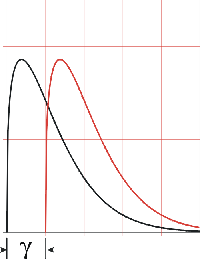Template:ParameterTypes: Difference between revisions
Kate Racaza (talk | contribs) No edit summary |
Kate Racaza (talk | contribs) No edit summary |
||
| Line 21: | Line 21: | ||
== Most Commonly Used Distributions == | == Most Commonly Used Distributions == | ||
There are many different lifetime distributions that can be used to model reliability data. Leemis and others [[Appendix | There are many different lifetime distributions that can be used to model reliability data. Leemis and others [[Appendix:_Weibull_References|[22]]] present a good overview of many of these distributions. In this reference, we will concentrate on the most commonly used and most widely applicable distributions for life data analysis, as outlined in the following sections. | ||
Revision as of 15:56, 12 March 2012
Parameter Types
Distributions can have any number of parameters. Do note that as the number of parameters increases, so does the amount of data required for a proper fit. In general, the lifetime distributions used for reliability and life data analysis are usually limited to a maximum of three parameters. These three parameters are usually known as the scale parameter, the shape parameter and the location parameter.
Scale Parameter
The scale parameter is the most common type of parameter. All distributions in this reference have a scale parameter. In the case of one-parameter distributions, the sole parameter is the scale parameter. The scale parameter defines where the bulk of the distribution lies, or how stretched out the distribution is. In the case of the normal distribution, the scale parameter is the standard deviation.
Shape Parameter
The shape parameter, as the name implies, helps define the shape of a distribution. Some distributions, such as the exponential or normal, do not have a shape parameter since they have a predefined shape that does not change. In the case of the normal distribution, the shape is always the familiar bell shape. The effect of the shape parameter on a distribution is reflected in the shapes of the pdf, the reliability function and the failure rate function.
Location Parameter
The location parameter is used to shift a distribution in one direction or another. The location parameter, usually denoted as γ, defines the location of the origin of a distribution and can be either positive or negative. In terms of lifetime distributions, the location parameter represents a time shift.
This means that the inclusion of a location parameter for a distribution whose domain is normally [math]\displaystyle{ [0,\infty] }[/math] will change the domain to [math]\displaystyle{ [\gamma ,\infty] }[/math] , where γ can either be positive or negative. This can have some profound effects in terms of reliability. For a positive location parameter, this indicates that the reliability for that particular distribution is always 100% up to that point. In other words, a failure cannot occur before this time γ. Many engineers feel uncomfortable in saying that a failure will absolutely not happen before any given time. On the other hand, the argument can be made that almost all life distributions have a location parameter, although many of them may be negligibly small. Similarly, many people are uncomfortable with the concept of a negative location parameter, which states that failures theoretically occur before time zero. Realistically, the calculation of a negative location parameter is indicative of quiescent failures (failures that occur before a product is used for the first time) or of problems with the manufacturing, packaging or shipping process. More attention will be given to the concept of the location parameter in subsequent discussions of the exponential and Weibull distributions, which are the lifetime distributions that most frequently employ the location parameter.
Most Commonly Used Distributions
There are many different lifetime distributions that can be used to model reliability data. Leemis and others [22] present a good overview of many of these distributions. In this reference, we will concentrate on the most commonly used and most widely applicable distributions for life data analysis, as outlined in the following sections.
